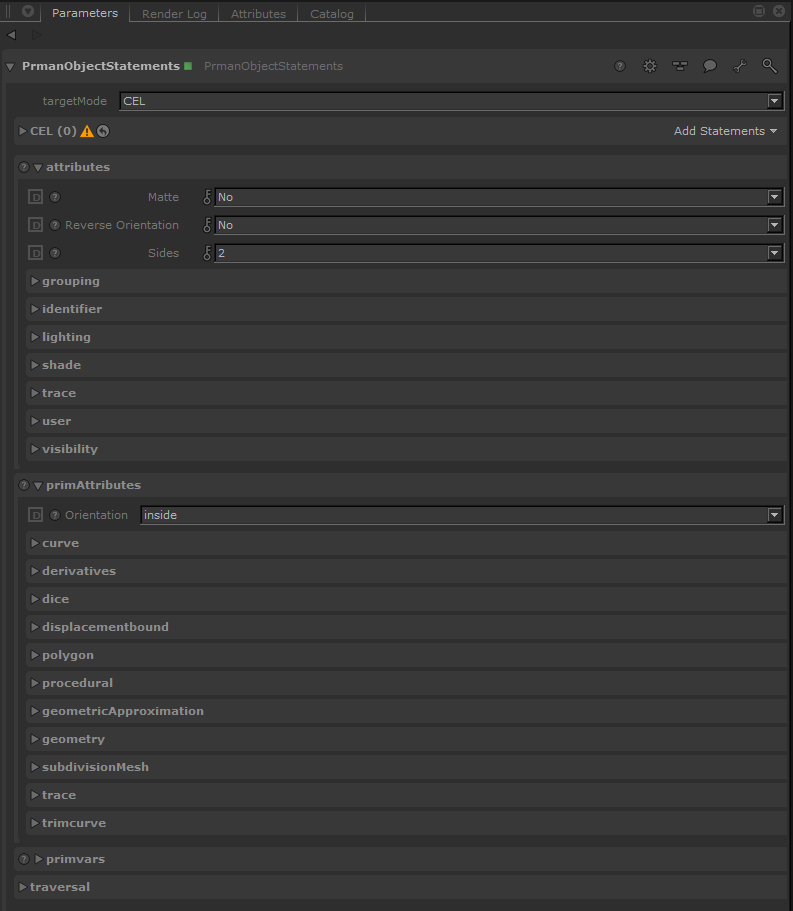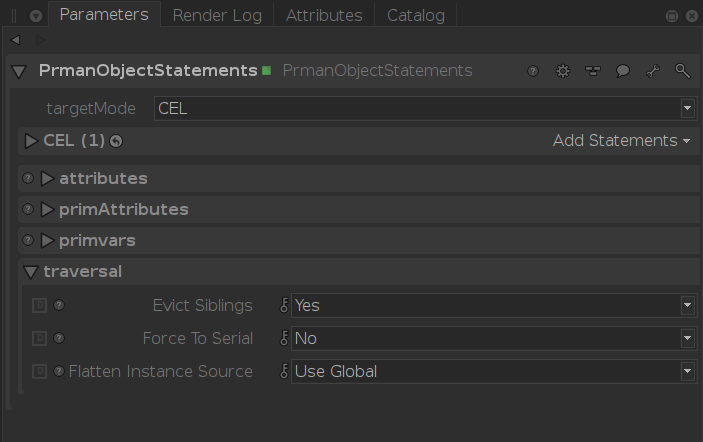Contents
The PrmanObjectStatements is assigned to a specific location or group of locations and translates into prman as setting the state for an AttributeBegin/AttributeEnd block. This node allows you to do things like assign a subdivision approximation to objects to render smooth surfaces, apply a displacement bound for rendering displacements, and changing visibility flags and memberships.
In RenderMan, there are different ways to choose how your object and its instances will render. These are conveniently divided in the node:
| Section | Description |
|---|---|
attributes | Attributes which can be varied across instances (e.g. |
primAttributes | Per-primitive attributes which are considered "master" properties (referred to in the table below as "Primitive Variables") |
primvars | Constant per-primitive attributes which are part of the primitive definition. These cannot be varied per-instance. |
traversal | RfK plugin controls for scene traversal. |
The settings are listed in the tables below. Note that the tables do not currently line up exactly with the PrmanObjectStatements UI presentation of the parameters.
PrmanObjectStatements: attributes
PrmanObjectStatements: primAttributes
These may also be referred to as "master attributes" for clarity versus Instance Attributes which may be varied per instance.
Common
Name | Type | Default | Description |
|---|---|---|---|
| identifier:object | string | empty | Object shape name. |
Shading
Name | Type | Default | Description |
|---|---|---|---|
| derivatives:extrapolate | integer | 1 | Extrapolated smooth normals across grid boundaries. |
| displacement:ignorereferenceinstance | int | 0 | Indicates if displacement shading should ignore properties of the reference instance. |
| displacementbound:CoordinateSystem | string | object | The name of the coordinate system that the displacement bound is measured in. |
| displacementbound:offscreen | int | 0 | Apply displacementbound to offscreen geometry when dicing. Geometry that is entirely offscreen, but displaces into view may be prone to undertessellation because of the offscreen dicing strategy. This can be corrected by enabling this control and setting a reasonable displacementbound. Doing so will incur a performance penalty commensurate with the size of the displacement bound. |
| displacementbound:sphere | float | 0 | Maximum displacement distance used to compute object bounds. This value should be as tight as possible. |
| Ri:Orientation | string | outside | Geometry winding order that determines surface normal. This attribute effects lighting and displacement. Supported values: inside, outside. |
| trace:autobias | integer | 1 | Enable automatic raytrace bias. |
| trace:bias | float | 0.01 | Manual raytrace bias in object space. Small values should be used to avoid artifacts such as shadow acne. |
| trace:displacements | integer | 1 | Enable displacement shading. |
Dicing
Name | Type | Default | Description |
|---|---|---|---|
| dice:micropolygonlength | float | 1 | Micropolygon distance in raster space for "instanceprojection" dicing. Values are expressed in pixel size. |
| dice:offscreenstrategy | string | viewfrustumdistance | Dicing method of objects outside the viewing frustum. Supported values: viewfrustumdistance, worlddistance, objectdistance. |
| dice:rasterorient | integer | 1 | Changes micropolygon size according to the viewing angle of a surface. When rasterorient is on, surfaces are coarsely diced at a glancing angle.This feature is very useful for ground planes and other large objects that are seen at an angle and it should be disabled for geometry that is instanced several times as it can be seen from different angles as well as when displacement details are lost. |
| dice:referencecamera | string | empty | Specify the camera used for dicing. If no reference camera is specified, RenderMan will use the primary camera. |
| dice:referenceinstance | string | empty | Specify the reference instance used for dicing and displacement shading. The reference instance is used to drive dicing and displacement based on its position, scale, user attributes, and scoped coordinate systems. Reference instances are specified by its identifier:name attribute (instance name). If no reference instance is specified, RenderMan will automatically pick the nearest instance inside the primary camera's view frustum. |
| dice:strategy | string | instanceprojection | Dicing method of objects within the viewing frustum. Supported values: instanceprojection, worlddistance, objectdistance. |
| dice:worlddistancelength | float | -1 | Micropolygon distance in world space for "worlddistance" dicing or object space for "objectdistance" dicing. |
| Ri:GeometricApproximationFocusFactor | float | 0 | Allows the renderer to use more coarse dicing for blurry objects due to depth of field. |
| Ri:GeometricApproximationMotionFactor | float | 0 | Allows the renderer to use more coarse dicing for blurry objects due to motion blur. |
Points
Name | Type | Default | Description |
|---|---|---|---|
| falloffpower | float | 0 | For use with points, if not supplied, or set to zero, the points will have a hard edge. A value of 1 is a "reasonable" value that emulates the usual cosine based falloff; this will likely be the goto value for most people doing volumetric particle effects. Values between 0 and 1 makes the falloff faster, eroding the point faster - point has "less presence". Values higher than 1 (up to infinity) makes the falloff slower to the point of being non-existent. |
Volume
Name | Type | Default | Description |
|---|---|---|---|
| dice:minlength | float | -1 | Volume minimum dice length. Negative indicates to automatically compute this value. |
| dice:minlengthspace | string | empty | Coordinate space of dice:minlength. |
| Ri:Bound | float[6] | 0 0 0 0 0 0 | Volume bounds. |
| volume:dsominmax | integer | 0 |
SubdivisionMesh
Name | Type | Default | Description |
|---|---|---|---|
| dice:pretessellate | integer | 1 | Pre-tessellate subdivision geometry to polygons. |
| dice:watertight | integer | 0 | Tessellate geometry with no holes. Watertight geometry requires less raytrace bias. |
| shade:faceset | integer[n] | empty | Active geometry face indexes. |
| stitchbound:CoordinateSystem | string | empty | |
| stitchbound:sphere | float | 0 |
NuPatch
Name | Type | Default | Description |
|---|---|---|---|
| trimcurve:sense | string | inside | Supported values: inside, outside. |
PolygonMesh
Name | Type | Default | Description |
|---|---|---|---|
| polygon:concave | integer | 1 | Allow concave polygons. |
| polygon:smoothdisplacement | integer | 0 | Output smoothed (per-vertex) normals as Ndsp primvar, if polygon:smoothnormals hasn't already inserted smooth normals. |
| polygon:smoothnormals | integer | 0 | Smooth (per-vertex) normals if not provided. |
Procedural
Name | Type | Default | Description |
|---|---|---|---|
| procedural:immediatesubdivide | integer | 0 | |
| procedural:reentrant | integer | 0 |
PrmanObjectStatements: primvars
Name | Type | Default | Description |
|---|---|---|---|
| falloffpower | float | 0 | Falloff power for point primitives. |
Traversal
As RfK traverses the Katana scene graph it will process locations in parallel and pass them to RenderMan for rendering. By default each new child location retrieved from Katana will spawn a new thread for processing. This default behavior is unlikely to give the optimal performance for any given scene, however there are tools available for tuning the efficiency and the level of parallelism for a particular pipeline (e.g. your studio's standard Op Chain) or various types of scenes (e.g. many instances, many textures, many primitives, or perhaps all three).
Name | Type | Default | Description |
|---|---|---|---|
| forceSerial | int | 0 | Force traversal to serial processing for this and child locations. |
| evictHere | int | 1 | Prevent sibling eviction at this location. |
| flattenInstanceSource | int | 2 | Flatten hierarchical instance source locations. |
The first tool is an attribute to control the depth of parallelism in your scene: forceSerial.
For example, take a scene:
/root/world/geo/pine_tree
/root/world/geo/elm_tree
/root/world/geo/oak_tree
with each tree location containing branches, leaves, roots, etc.
Ideally you traverse this in parallel at a high-enough level that it's not trying to do every leaf or every branch on a different thread. We do this in RfK by setting "prmanStatements.traversal.forceSerial" to True at the location where we want to stop processing in parallel. When that attribute is encountered during traversal RfK will switch to serial at that location and all child locations will be run in a single thread.
In the above example, setting "forceSerial" to true on "/root/world/geo/*_tree" means that each tree will be on a different thread, but all the contents of each tree will be serially processed in their respective threads. You'll need to evaluate your scene setup to see at what level it makes sense to force serial processing.
Each thread has it's own Geolib runtime containing per-thread caches of cooked locations. As a result all locations needed for any Op would to be cooked per-thread. Continuing with the above example: if you have three threads each looking at different locations under "/root/world/geo", you'll see "/root" cooked three times, "/root/world" cooked three times and "/root/world/geo" cooked three times. If you are running serial, or forcing the parallel traversal to one thread at "/root" then you'll only have one Geolib runtime cooking the location and so would see only a single print from that Op at "/root"
The second tool we have for parallel traversal efficiency is the evictHere setting.
By default siblings of a Katana scenegraph location will be evicted from a thread's runtime memory when a location is processed for conversion to the Rix scenegraph. Setting this flag false prevents sibling eviction at this location in the event it is known that those siblings are best kept in the cache for subsequent access.


